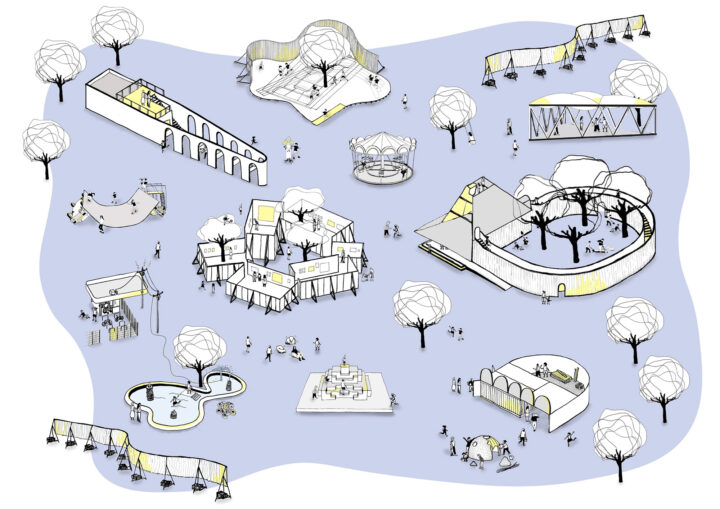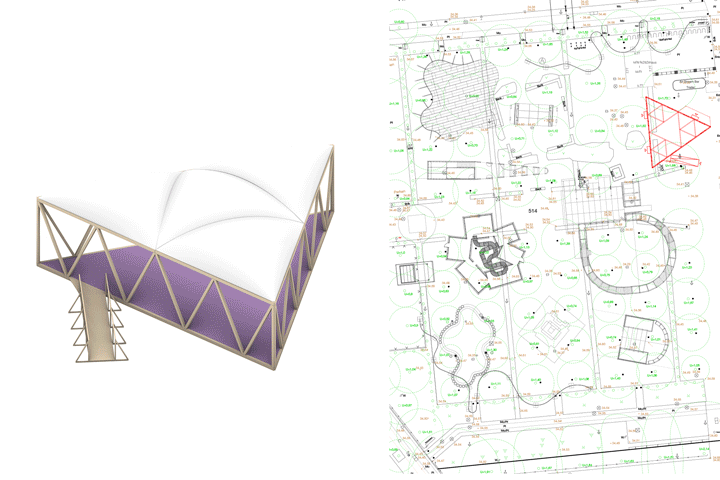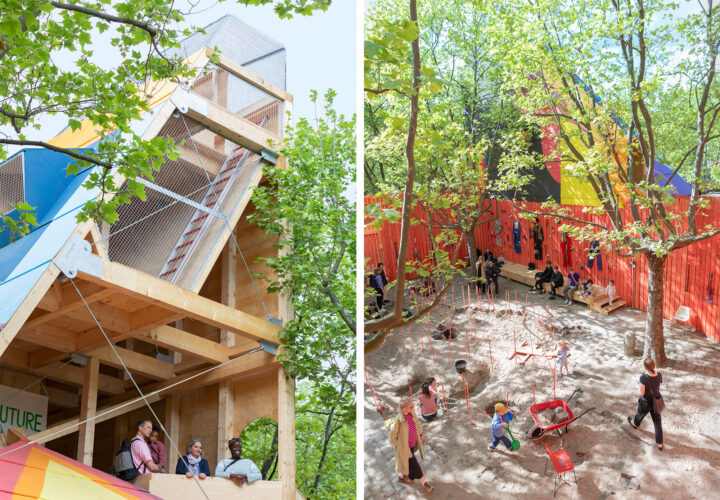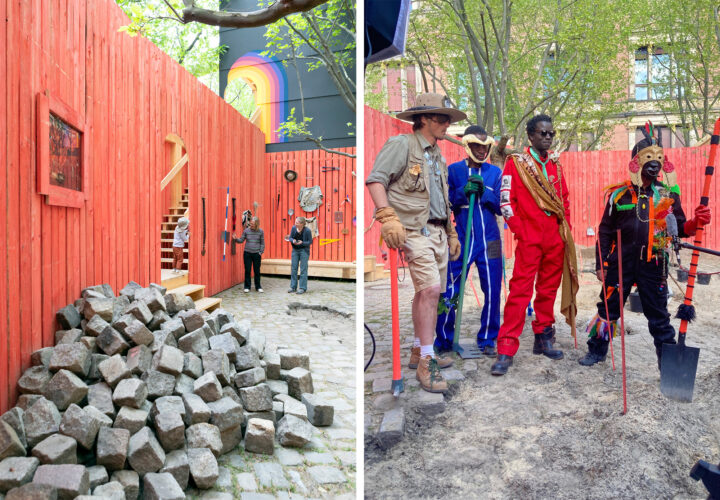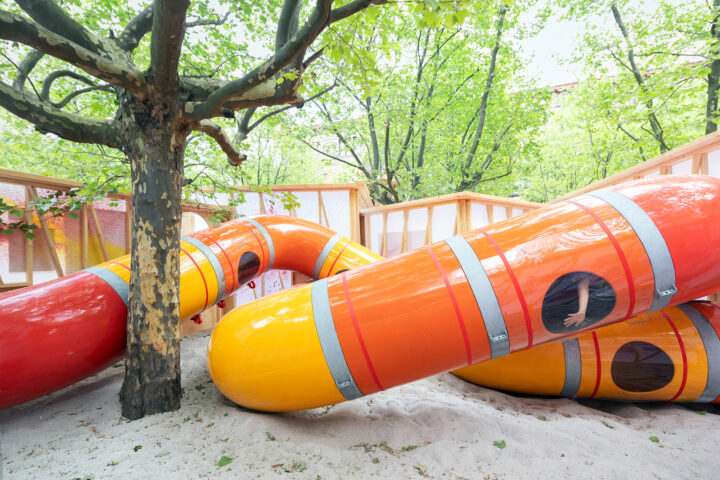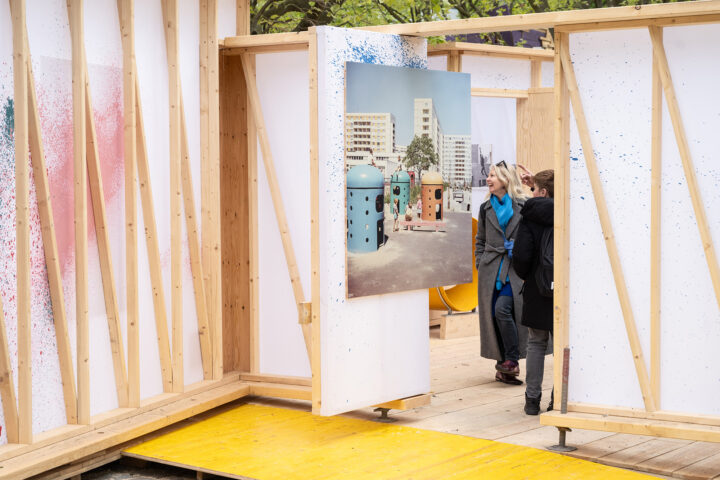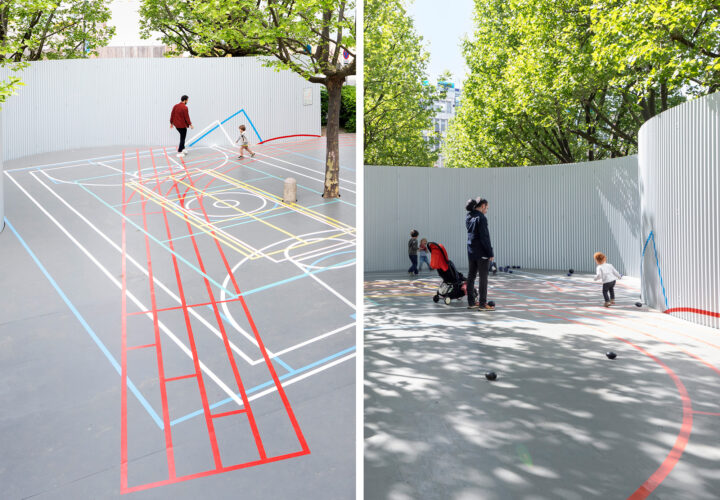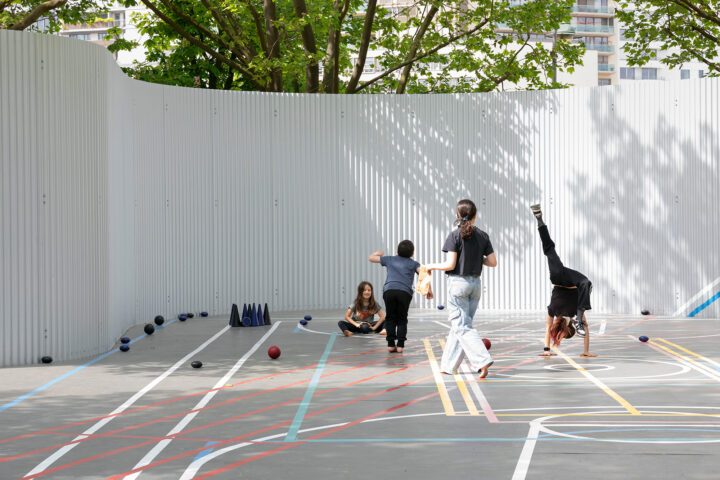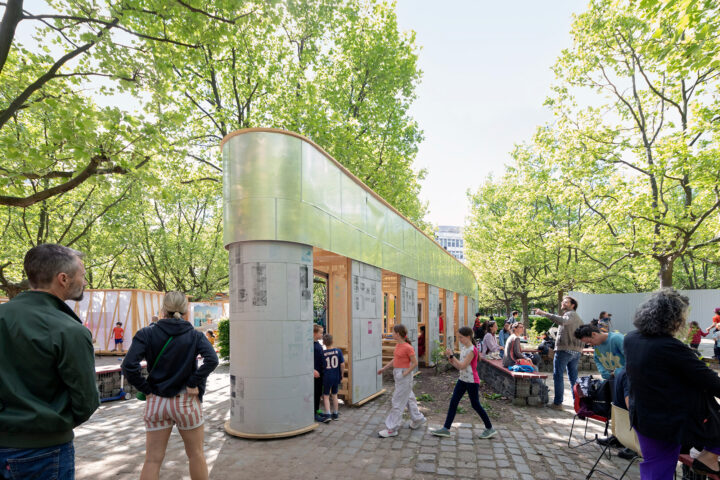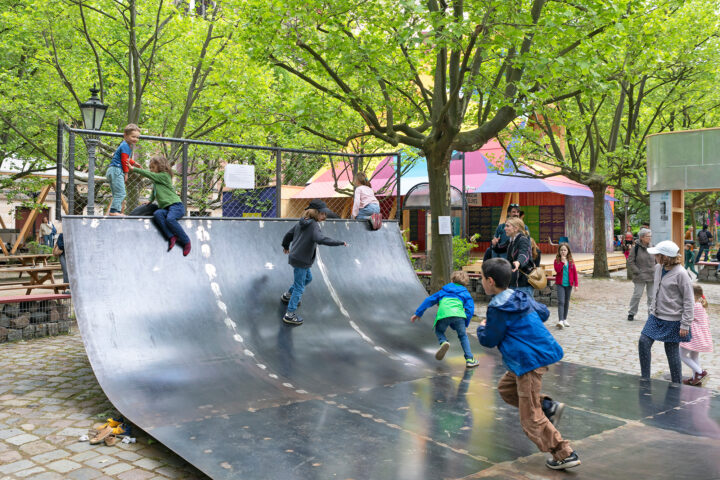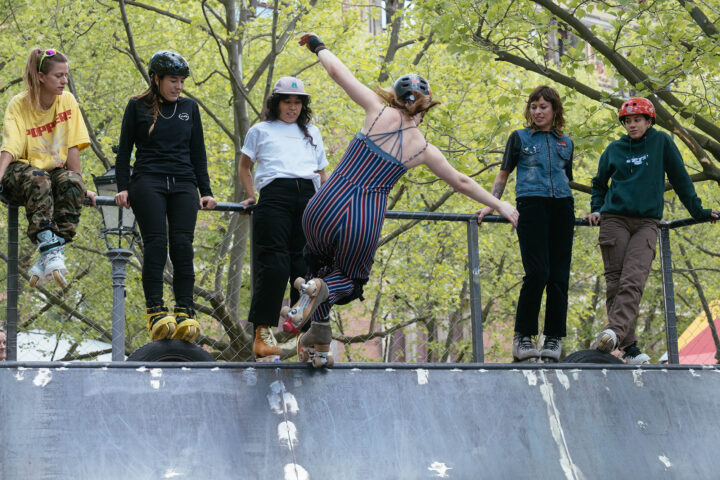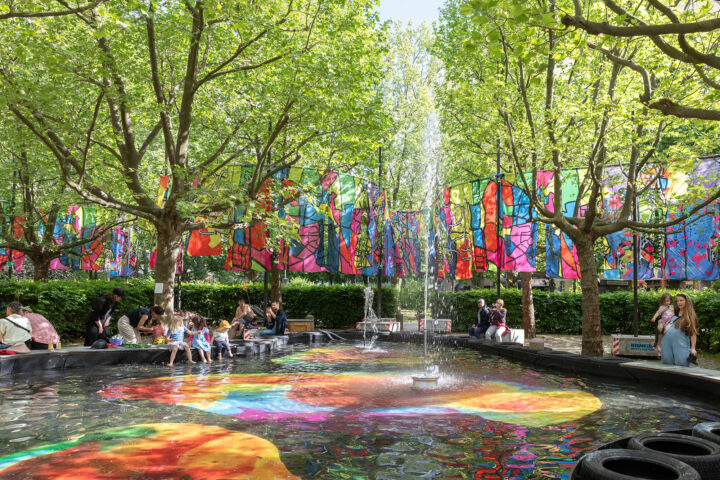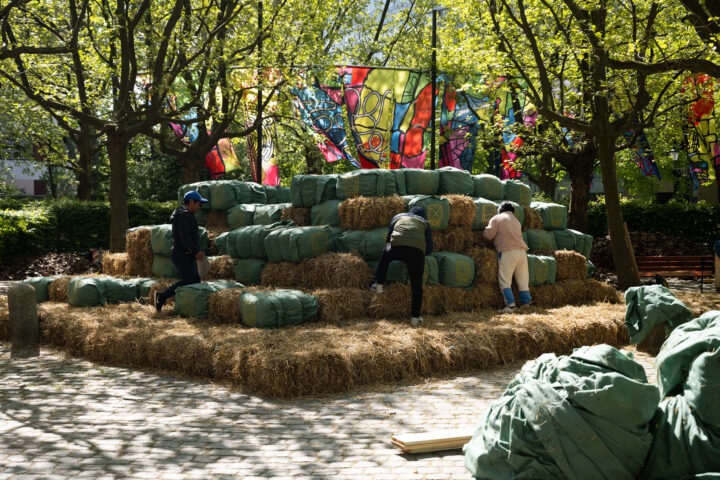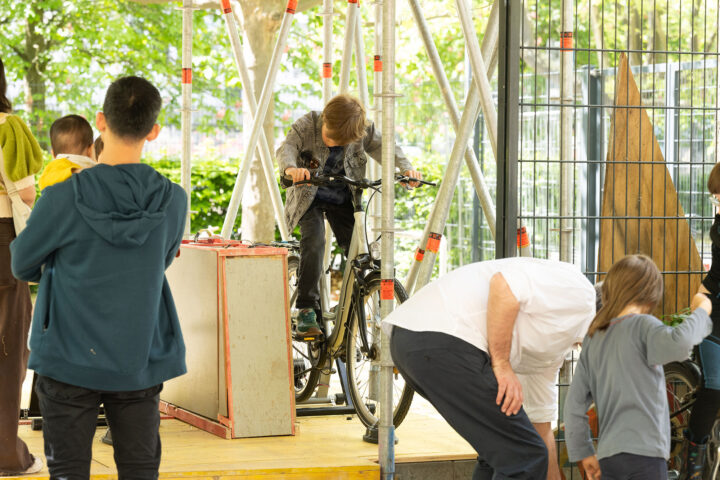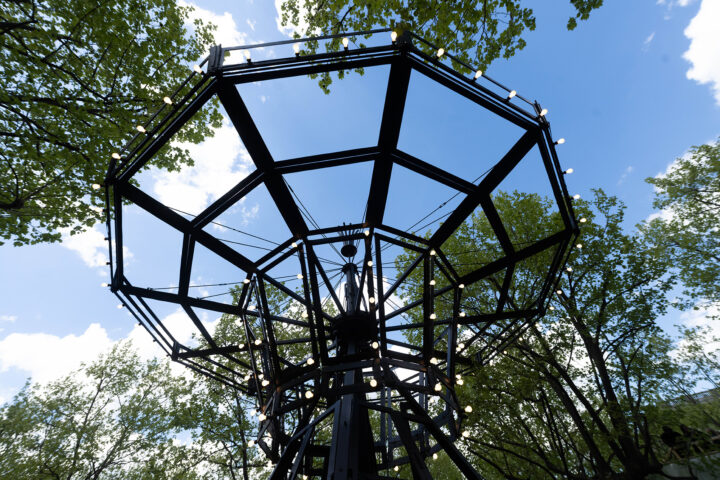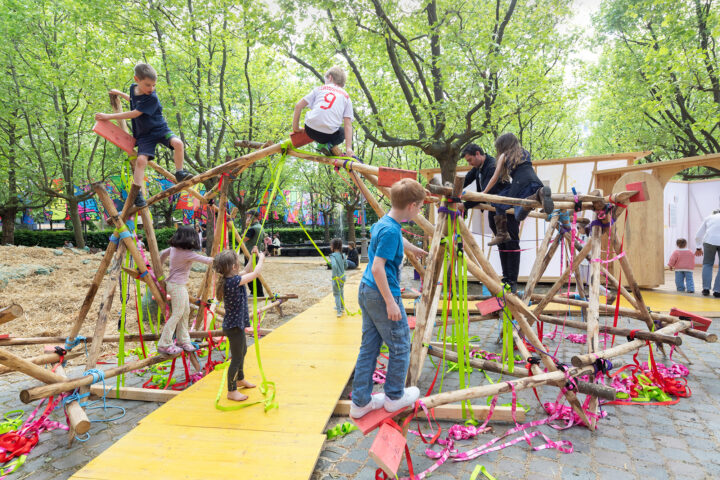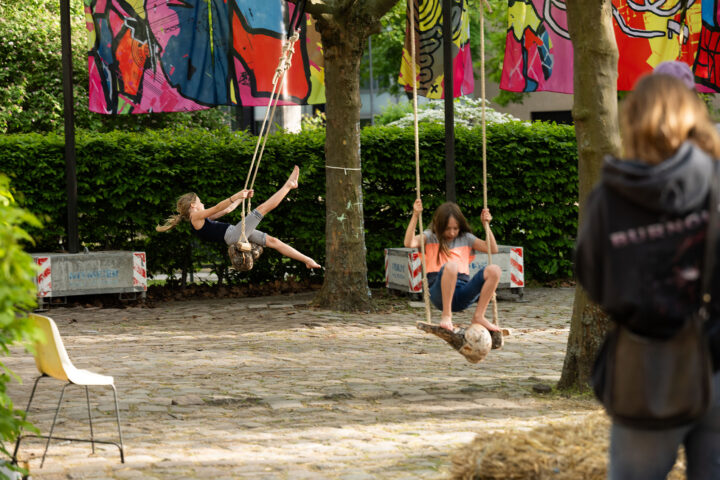Radical Playgrounds
Commissioned by Berliner Festspiele
27.4. – 14.7.2024
Funded by Stiftung Fussball & Kultur Euro2024, Hauptstadtkulturfonds (HKF), Bundeszentrale für politische Bildung (bpb)
Curators: Joanna Warsza, Benjamin Foerster-Baldenius
Technical management: Maria Kusche (Berliner Festspiele), Benjamin Frick (Berliner Festspiele)
Structure engineering: Florian Förster, Joanna Hedley-Smith (Buro Happold)
Building Team:
Alizée Serazin, Andrew Wu, Axel Timm, Batiste Supan, Carmen Staiano, Esther Bonneau, Fanny Benguigui, Finn Köhntop, Florent Marvier, Jan Schlake, Jonas Haala, Kipras Kazlauskas, Leonie Haasler, Louise Nguyen, Malin Mohr, Sam Boche, Yasmin Naqvi
Graphic Design The Playground Project: Lena Appenzeller
Companies: Holzbau Johannsen, Gerüstbau Tisch, Hertzer, Liquid Paint, Noibau, ErtlundZull, Stoffdach Construction
Titelfoto: © Juliane Eirich 2024
2024 ist das Jahr der Fußball-Europameisterschaft der Männer in Deutschland und alle reden über das Spielen, zumindest das Fußballspielen. Die Berliner Festspiele nehmen dieses Ereignis zum Anlass, um das Thema des Spielens aus einem anderen Blickwinkel zu betrachten – Spielen im öffentlichen Raum. Der Martin-Gropius-Bau bzw. dessen großzügige Parkfläche, wird Schauplatz oder besser gesagt ein Spielplatz für alle.
2024 is the year of the Men’s European Football Championship in Germany and playing is on everyone’s lips, at least playing soccer is. The Berliner Festspiele take this event as an opportunity to look at the topic of playing from a different angle – playing in public space. The Martin-Gropius-Bau, or rather its bountiful parking area, becomes the setting, a playground for everyone.
Kuratiert von Joanna Warsza und Benjamin Foerster-Baldenius entwickelt raumlaborberlin in Zusammenarbeit mit KünstlerInnen einen Park aus verschiedenen Pavillons, die die Vielschichtigkeit und Potentiale des Thema Spielen zeigen. Die Installationen wollen dabei jeweils eigenständig sein aber auch als großes Ganzes, als Radical Playground, funktionieren.
Curated by Joanna Warsza and Benjamin Foerster-Baldenius, raumlaborberlin worked with multiple artists to develop a park consisting of various pavilions that show the complexity and potential of the theme of play. Each installation is both independent and part of the whole, as a Radical Playground.
/ Freispielhalle und geheimer Garten (The Dig)
Die große Freispielhalle ist nicht nur Blickfang sondern auch ein Turm der Ausblick geben soll. Der 3-geschossige Holzbau inmitten des Playgrounds kann sowohl betanzt als auch beklettert werden und im angrenzenden geheime Garten (The Dig) sucht das Kunstkollektiv School of Mutants nach Überresten des preußischen Kolonialmuseums. Die in die rote Gartenmauer integrierte Wegeführung führt einen spielerisch auf und ab bis zur Spitze des Turms.
The large Freispielhalle is not only eye-catching, it is also a tower with a lookout. The 3-storey wooden structure in the middle of the playground can be both danced in and climbed on. In the adjacent secret garden (The Dig), the art collective School of Mutants search for remnants of the Prussian colonial museum. The path integrated into the red garden wall playfully leads you up, down and around to the top of the tower.
© Juliane Eirich 2024
© Camille Blake 2024 (unten rechts)
/ Beba
Aus Alt mach Neu. Aus dem HKW-Pavillon mach den BEBA-Pavillon. Die bereits 2023 entwickelte, dreieckige, überdachte Holzkonstruktion findet am Radical Playground eine neue Bestimmung und dient zukünftig als Satellit für das Gropius-Bau Restaurant BEBA.
Turning old into new. The HKW pavilion becomes the BEBA pavilion. The triangular, roofed wooden structure, which was developed in 2023, will find a new purpose at the Radical Playground and will serve as a satellite for the Gropius Bau restaurant BEBA.
/ Museum
Das man sich dem Thema Spielen nicht nur künstlerisch, sondern auch wissenschaftlich annähern kann, zeigt Gabriela Bulkhalter. In einem Open-Air Museum werden Bilder ihres Buches The Playground Project gezeigt und der von ihr erforschte Lozziwurm macht aus einem White-Cube-Museum einen Aktionsraum.
Gabriela Bulkhalter shows that the subject of play can be approached not only artistically but also scientifically. Pictures from her book The Playground Project are shown in an open-air museum and the Lozziwurm, which she researched, turns a white cube museum into an activity space.
© Juliane Eirich 2024
/ Endlose Bühne
Céline Condorelli thematisiert in ihrer Arbeit Play for Today das Ausgrenzen des Spielens, genauer genommen des Profisports. Betritt man die Endlose Bühne, steht man nicht nur auf einem Spielfeld sondern auf vielen. Die jeweils angeführten Jahreszahlen zeigen das Jahr in dem es für Frauen erlaubt war, das erste mal an der jeweilige Profisportart teilzunehmen. Die Wellblechwand soll dabei die Raumwirkung des Spielfeldes verstärken.
In her work Play for Today, Céline Condorelli addresses the marginalization in playing, or more precisely in professional sport. When you step on the Endless Stage, you are not standing on one playing field, but on many. The year indicated on each field names the year in which women were allowed to take part in the respective professional sport for the first time. The corrugated metal wall is intended to reinforce the spatial effect of the pitch.
© Juliane Eirich 2024
© Camille Blake 2024
/ Gemeinschaftspavillon
Im Gemeinschaftspavillon soll die Gemeinschaft im Mittelpunkt stehen und daher steht dieser Pavillon auch auf der Mitte des Platzes. Der schmal zulaufende eingeschossige Bau mit begehbarer Dachterrasse, dient sowohl als Ausstellungsfläche für die Arbeit von Agnieszka Kurant, als auch als Treffpunkt für alle. An der mit Alupaneele verkleideten Fassade finden die Buchdruckplatten von Gabriela Bulkhalters Buch The Playground Project eine neue Bestimmung.
In the community pavilion, the focus is on the community, which is why this pavilion is located in the middle of the square. The narrow, single-storey building with an accessible roof terrace serves both as an exhibition space for Agnieszka Kurant’s work and as a meeting place for everyone. The letterpress plates from Gabriela Bulkhalter’s book The Playground Project find a new purpose on the façade, which is clad in aluminum panels.
© Juliane Eirich 2024
/ Skaterampe
Bent Metal on 2 Cars war die Aufgabenstellung für die von Florentina Holzinger konzipierte und von raumlaborberlin entworfene Installation. Die zwischen zwei Autos gebogene Halfpipe zeigt auf eine ironische Art das Potential von Autos in Innenstädten auf. Dass Halfpipes auch anders genutzt werden können und wieviel Potential darin steckt, zeigt wiederum die vielfältige Nutzung durch die Kleinsten.
Bent Metal on 2 Cars was the brief for the installation conceived by Florentina Holzinger and designed by raumlaborberlin. The halfpipe bent between two cars ironically demonstrates the potential of cars in city centers. The fact that halfpipes can also be used in other ways and how much potential they hold is demonstrated by the diverse ways in which they are used by the children.
© Juliane Eirich 2024
© Camille Blake 2024
/ Vorhänge und Pool
Die von der Ferne sichtbaren Vorhänge von Vitjitua Ndjiharine sind inspiriert von Straßen, Landkarten, Wegen sowie durch Konstellationen von Raum und sozialer Infrastruktur, die sie zumeist in Namibia findet.
Raul Walchs Fountain of Knowledge lädt zum Abkühlen unter Bäumen ein. Die im Pool sichtbaren Farben sind eine Wärmebildkarte von Berlin an den heißesten Tagen.
Vitjitua Ndjiharine’s curtains, visible from afar, are inspired by streets, maps, paths and constellations of space and social infrastructure, most of which she finds in Namibia.
Raul Walch’s Fountain of Knowledge invites you to cool off under the trees. The colors visible in the pool are a thermal map of Berlin on the hottest days.
© Juliane Eirich 2024
/ Pyramide
Edgar Calel möchte mit seinem Mountain of Drawings zeigen, wie man aus geheimnisvollen mystischen Maya-Pyramiden, Orte des Spielens ableiten kann. Die einzelnen Strohballen sind mit Maya-Symbolen, 20 Nahuales des Kalenders, bedeckt.
With his Mountain of Drawings, Edgar Calel wants to show how places of play can be derived from mysterious mystical Mayan pyramids. The individual bales of straw are covered with Mayan symbols, the 20 nahuales of the calendar.
© Camille Blake 2024
/ Energietankstelle
Für Martin Kaltwasser († 2022) waren Autos und Stadt immer schon zwei Gegensätze die sich nicht anziehen sollen. Die Energietankstelle ist eine Installation des Austobens und lädt ein, das eigene energetische Potential auf die Pedale zu bringen und zu beobachten was man alles in Bewegung setzen kann.
For Martin Kaltwasser († 2022), cars and the city have always been two opposites that should not attract each other. The power station is an installation for letting off steam and invites you to put your own energetic potential into the pedals and see what you can set in motion.
© Camille Blake 2024
/ Karussell
Mariana Telleria hat sich dem „lyrischen Materialismus“ verschrieben und zeigt ein Karussell wie man es eigentlich nicht erwartet. Die schwarz eingefärbte Holz-Stahl Konstruktion möchte einen geheimnisvollen Blick auf Spielplätze werfen.
Mariana Telleria has dedicated herself to „lyrical materialism“ and presents a carousel that you wouldn’t actually expect. The black-colored wood and steel construction invites you to take a mysterious look at playgrounds.
© Camille Blake 2024
/ Workshops und Aktion
Workshop with umschichten
© Juliane Eirich 2024
A Birch Tree Burr Swing by Joa Nango
© Camille Blake 2024

